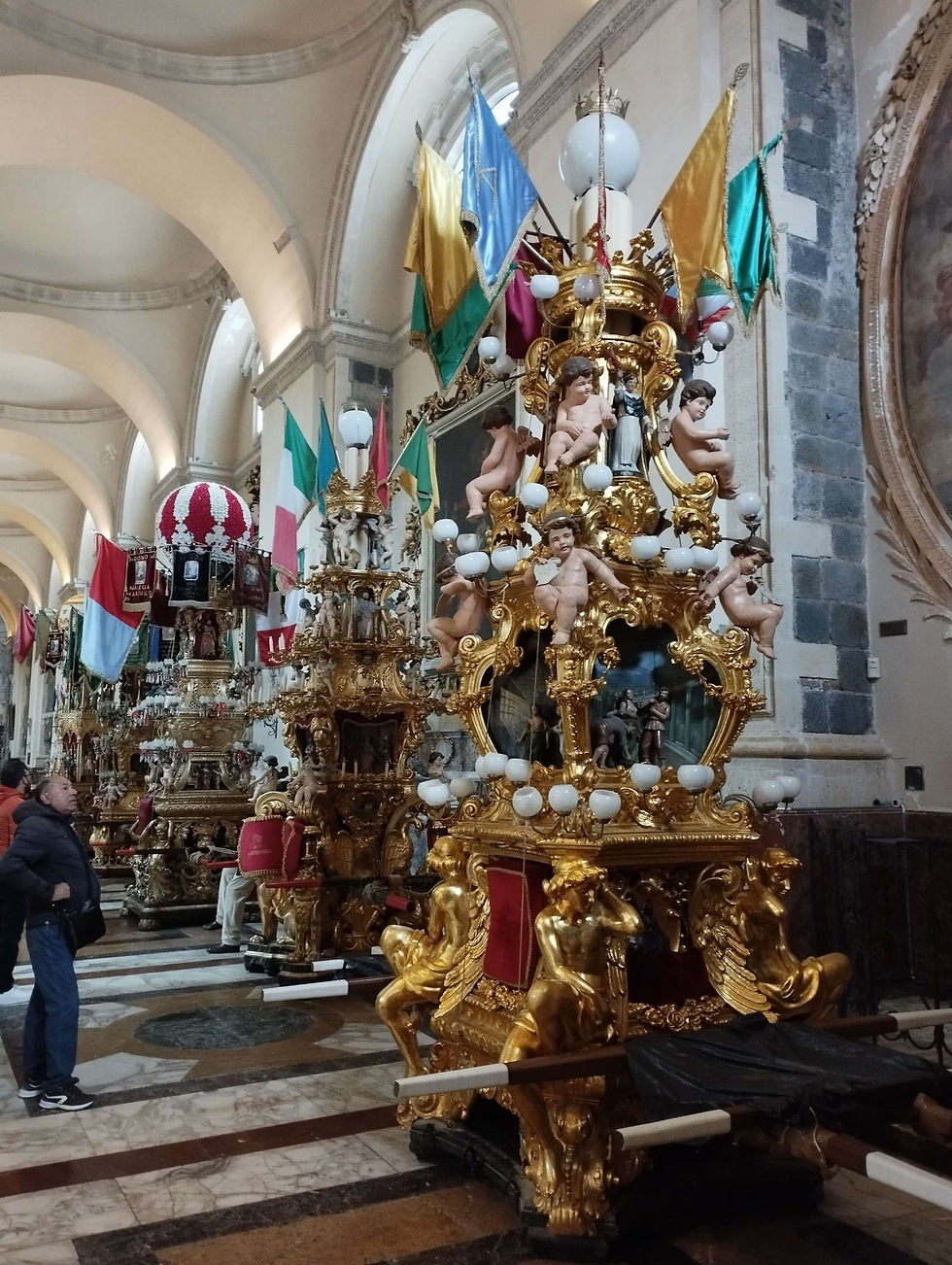Sicily Break - St Agatha and Syracuse
- adunsy
- Feb 18, 2024
- 4 min read
Another big day ahead with looking around Catania and then off to Syracuse. We just missed fest day of St Agatha on 5th February the local patron saint of Catania. For those keen liturgists would know that she is honoured in the Canon of the mass in the first Eucharistic prayer, along with six other female martyrs. She is a big deal in Catania.
Me in front of a Greek ampithiter in Syracuse dating back to at least 400BC.

St Agatha's Cathedral in Catania.

St Agatha's altar, her remains are in a reliquary which is positioned to the right of the altar.

St Agatha Cathedral nave.

The side naves had at least a dozen floats that were carried during the massive street procession, apparently there were a million people who turned up to participate in it😲.

A photo of the street parade with St Agatha's reliquary and the lantern floats beside it.

The largest church in Sicily is in Catania and is called St Nicholas. Measuring 105 meters long and 48 meters wide. It looks incomplete with the pillars only going halfway up the walls, which it is. With the many holes on the wall to mount marble facing. Construction began in 1687, it is still a functional church with the interior being completed.

Inside St Nicholas.

Beside St Nicholas' church there is a former Benedictine monastery founded in 1558, that is now used by a government university. They take tours of the monastery as it still retains a lot of its religious artworks and history.

One of the cloisters in the monastery.

The refectory ( dinning hall) now turned into a lecture room. Seth is settling in for another lecture.

There is still some amazing religious artwork adorning the ceiling.

A amazing fact about this monastery that ii survived two natural disasters one in 1669 when mount Etna erupted and lava flowed over the town and stopped 20 meters from the buildings due to a big sand bank the had been placed around the building to stop the lava flow. As you can see to the right that walk is made up of lava. The other natural disasters was the an earthquake in 1693, where the monastery was partially destroyed and had to be rebuilt.

The lava wall.

After touring the churches in the morning we headed down to the local fish market and found a restaurant that severd up the mornings catch.

The restaurant.

After lunch we drove down the coast to Syracuse which was a 40 min away. There are many things to see in Syracuse but we had limited time but one thing we wanted to see was the archeological site which contains and Greek Ampithiter, a Roman Ampitheatre and the quarry that it was all mined from.
The Greek Ampithiter dates back to the 5th Century BC. It has 59 rows and could hold up to 15 thousand spectators.

The Roman Ampithiter situated across the park from the Greek Ampithiter dates back to the first century BC. It is more in the style of the Coliseum in Rome and would have been used for gladiator fights, it is one of the biggest in Italy.

Most of the two Ampitheatres were made by carving into the stone mountain side but for the rest of the stone needs, probably to build the rest of the city, they got from the quarry just to the back the Ampitheatres.

Apparently when the Greeks moved to Syracuse the brought with them 7000 prisoners of war that were kept here to cut out the stone. The size of the caves is amazing they sure were busy. In later centuries theses caves were used for rope making as the humidity in the caves kept the twine flexible and strong.

Obviously someone had too much time on their hands, with this cave being carved in the form of a funnel standing about 30 metres high and winding back into the cliff nearly 60 meters.

Inside the cave looking back towards the opening. As you can see the walls are very smooth and simetrical, making for very good accoustics. It is said that the emperor Dionysius could hold his prisoners in here and listen to every word they said.

While driving into Syracuse we could see a huge building that broke the city skyline. This is the Basilica of our Lady of Tears.

Standing at over 100 meters high from ground level and it is designed to look like a giant teardrop. It was built from 1988 to 1994 to house a statue of the Madonna that supposedly wept for 5 day's in 1953. It was inaugurated by St John Paul II in 1994.

Inside the Basilica.

The statue of the Madonna behind thee altar a below the crisifix.

Looking up at the great spire with the sunlight coming through the windows.

This concluded our trip to Sicily a week packed with amazing sites, stories and people. It was a quick dash back to the airport in Catania for our flights back to Rome. What we needed after this was a week of retreat to prepare for the new term. Nemi here were come.
Mount Etna as viewed from the Catania airport. It is still active today with a trail of black smoke can be seen coming from the peak.



Impressive!